Accepted Scientific Name: Glottiphyllum nelii Schwantes
Möller's deutsche gärtner-zeitung Möller
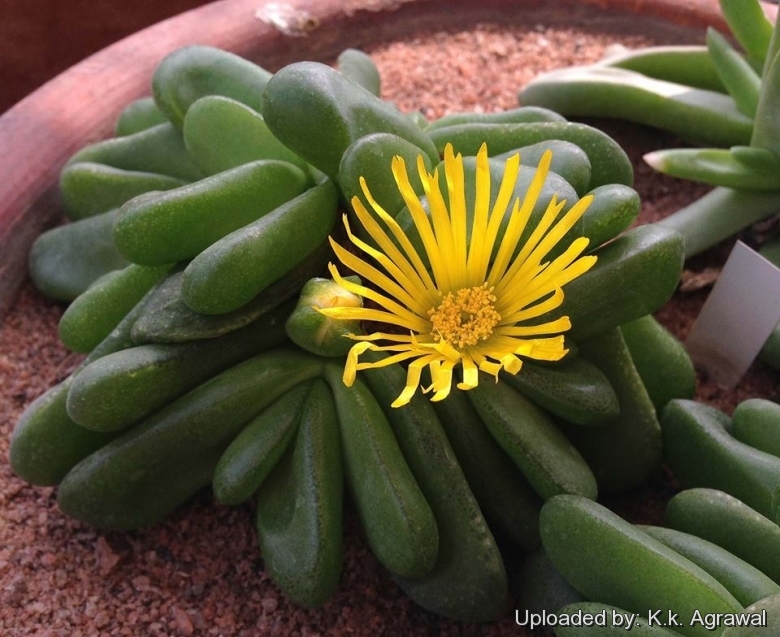
Glottiphyllum pygmaeum Photo by: K.k. Agrawal
First flowering of the season.
Origin and Habitat: South Africa (Little Karoo: Oudtshoorn)
Habitat: They grow in rocks under bushes or in open. The soisl incorporate slate, sandstone and (mostly) quartz. Rainfall in their native areas is between 100 and 200 mm, especially in March and November. Some plant in habitat have scars or burst in their skins, just like they do at home.
Synonyms:
See all synonyms of Glottiphyllum nelii
back
Accepted name in llifle Database:Glottiphyllum nelii SchwantesMöller's deutsche gärtner-zeitungSynonymy: 3
back
Common Names include:
ENGLISH: Tounge-Leaf
Description: The G. pygmaeum is dwarf form of Gibbaeum nelii, often confused with Gibbaeum neilii. It is a compact, rambling succulent with up to 5 branches (or more with age). It is dormant in high summer heat, and dormant in the darkness of a cold winter, but otherwise happy to grow whenever it is watered. The dimension varies from 15 cm tall and 30 cm in diameter in the standard form to only a few cm in diameter and height in the “pygmaeus” form (but often more in cultivation). Given insufficient light and too much water, they grow into great sprawling masses of fat, bright green leaves. Given a very bright position, the leaves are dark green, almost black at times, with red and purple. There are indeed marked differences in sizes of leaf and flowers in plants from different population and also the growing condition (especially sun exposure and water availability) determine conspicuous differences in habit of cultivate specimens.
Stem: Almost stem less or very short stemmed.
Leaves: The plant produces several, distichous leaves in 2 to 4 (or more) ranks on each branch. They are soft, dark green, glossy to waxy grey. Leaves have rounded, rarely sharp, edges dotted with dark rounded idioblast. They are succulent and very juicy in texture, reminiscent of gummy bears, in full sun they assume a purplish colouring
Fruits: Persisting in the center of the plant.
Flowers: Long-lived, yellow, daisy-like and very showy.
Blooming season: Late summer-autumn.
Subspecies, varieties, forms and cultivars of plants belonging to the Glottiphyllum nelii group
Bibliography: Major references and further lectures
1) Heidrun E.K. Hartmann “Illustrated Handbook of Succulent Plants: Aizoaceae F-Z” Springer Science & Business Media, 2002
2)Doreen Court “Succulent Flora of Southern Africa” CRC Press, 01/Jun/2000
3) Gideon Smith u.a. (Hrsg.) "Mesembs of the World: Illustrated Guide to a Remarkable Succulent Group." Briza Publications, 1998
4) James Cullen, Sabina G. Knees, H. Suzanne Cubey “The European Garden Flora Flowering Plants: A Manual for the Identification of Plants Cultivated in Europe, Both Out-of-Doors and Under Glass” Cambridge University Press, 11/ago/2011
5) Hermann Jacobsen “A handbook of succulent plants: descriptions, synonyms, and cultural details for succulents other than Cactaceae, Volume 1” Blandford Press, 1960
6) Werner Rauh “The Wonderful World of Succulents:Cultivation and Description of Selected Succulent Plants Other Than Cacti” Smithsonian Institution Press, 1984
7) Ed Storms “Growing the Mesembs” Tarrant Printing, 1976
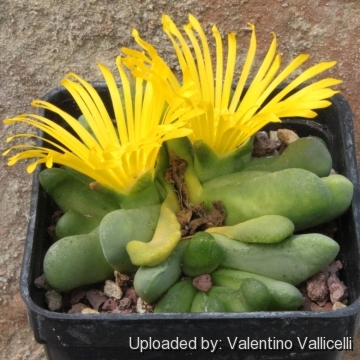 - It produces wonderful small growing green or purple tongue-like round leaves. The flowers are a very cheerful yellow daisy flower. Photo by: Valentino Vallicelli
- It produces wonderful small growing green or purple tongue-like round leaves. The flowers are a very cheerful yellow daisy flower. Photo by: Valentino Vallicelli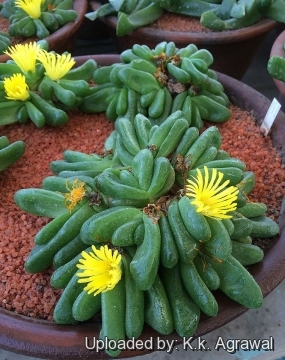 Double layered glottiphyllum pygmaeum. Photo by: K.k. Agrawal
Double layered glottiphyllum pygmaeum. Photo by: K.k. Agrawal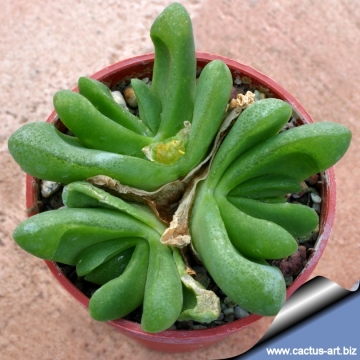 Glottiphyllum pygmaeum Photo by: Cactus Art
Glottiphyllum pygmaeum Photo by: Cactus Art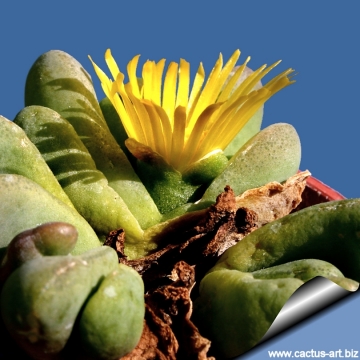 Glottiphyllum pygmaeum Photo by: Cactus Art
Glottiphyllum pygmaeum Photo by: Cactus Art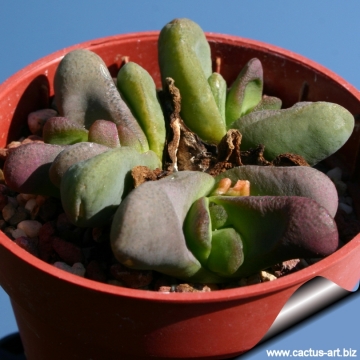 Glottiphyllum pygmaeum Photo by: Cactus Art
Glottiphyllum pygmaeum Photo by: Cactus Art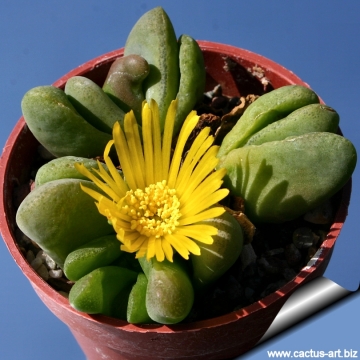 Glottiphyllum pygmaeum Photo by: Cactus Art
Glottiphyllum pygmaeum Photo by: Cactus Art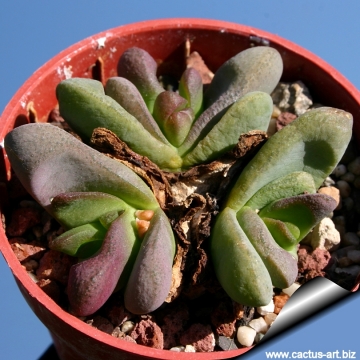 Glottiphyllum pygmaeum Photo by: Cactus Art
Glottiphyllum pygmaeum Photo by: Cactus ArtSend a photo of this plant.The gallery now contains thousands of pictures, however it is possible to do even more. We are, of course, seeking photos of species not yet shown in the gallery but not only that, we are also looking for better pictures than those already present.
Read More... Cultivation and Propagation: The plants in this genus represent some of the more easily cultivated succulent species. Their main growth period is in late winter and were heading for spring-summer dormancy, but they do best with at least a little water all year. Requires little water otherwise their epidermis breaks (resulting in unsightly scars). Water moderately from the middle of summer to the end of winter, and keep the compost almost dry when the plants are dormant. Water minimally in spring and summer, only when the plant starts shrivelling (, but they will generally grow even in summer if given water) In areas prone to frost, grow in an intermediate greenhouse or conservatory, in pots of cactus compost, obtainable from good garden centres. Keep cool and shaded in summer, but provide maximum light the rest of the year. However there are two ways to grow glottiphyllums: The first is to let nature take her course, which means giving them large pots and copious water; they will burgeon into enormous masses of glistening green leaves. The other is to starve them into svelteness by hot summer droughts, small pots, and firm loam. The results can be very attractive. In any case it is best to treat them as late winter growers. Soft leaves mean easy to damage.
Propagation: Seeds or cuttings. Seeds can be sown in early to mid-spring and germinated in heated humid environment. Alternatively, use stem cuttings taken towards the end of summer in an heated propagating case (15-21°C)
Notes: The 50 or so species of this South African genus of succulents are so similar that many may be hybrids.

















